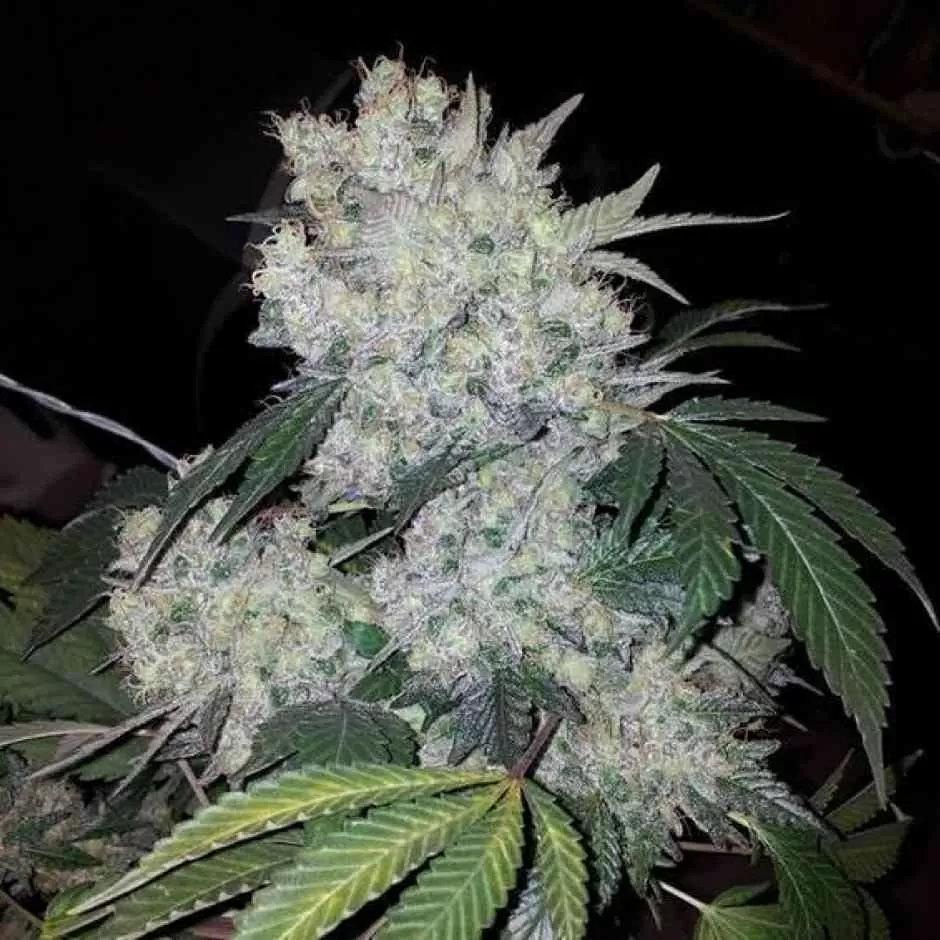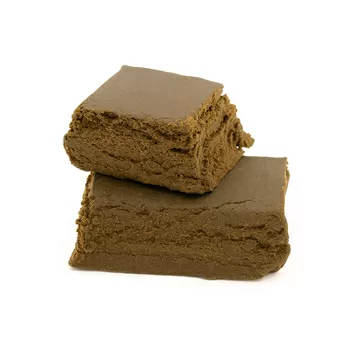Known the world over, White Widow is a legendary hybrid cannabis strain known for its extraordinary potency and concentration of active ingredients and widely used for both medicinal and recreational purposes, a must in Amsterdam and the Netherlands' most popular coffee shops.
Although the origins of these genetics are unknown to this day, White Widow has gradually become one of the most popular marijuana strains. What makes White Widow unique is the extraordinarily generous amount of crystalline trichomes that cover her inflorescences and which helped inspire her name.
According to a myth surrounding White Widow herself, the strain was originally grown selectively in the mountains of Kerala in southern India. However, her geographical origins are currently known: she was first created in the 1990s by Green House Seeds in the Netherlands from the hybridisation of Brazilian cannabis indica genetics with Indian cannabis sativa varieties. The strength of the White Widow cannabis strain is undoubtedly her inflorescences, which are covered in thick, milky 'crystals' with a characteristic 'sugary' appearance and a typically white colour: the plant has a tendency not to pigment its trichomes even when the inflorescences are perfectly ripe and full of resin. Generally rather low, the leaves are intensely green and elongated, while the inflorescences emit a pungent, mainly earthy, woody and spicy smell similar to pepper combined with citrus. The smoke produced by combustion is deliciously sweet, citrusy, fresh and almost balsamic with a slight floral tendency.
As a predominantly sativa variety with an indica/sativa ratio of 40:60, White Widow prefers the sun and warmer climate of its home territory. She is low maintenance and tolerates the typical Northern European climate quite well. Its flowering period lasts for about 60 days and each plant can produce up to 55/65g of inflorescences.
When choosing to buy White Widow cannabis seeds, it is worth bearing in mind that they are mainly suited to indoor cultivation, being prone to hydroponics. Experts favour hydroponics because of the faster flowering time compared to outdoor growing, although it is widely recommended to keep the humidity low to protect the plants from mould, and to keep the temperature between 21 and 26°C to allow them to develop quickly and optimally. Feminised seeds are still the best option for beginners wishing to try their hand at growing White Widow indoors.
Why White Widow is so popular with cannabis enthusiasts
Since its inception in 1995, White Widow has become one of the most popular marijuana strains, appearing in Amsterdam's best coffee shops. There are many variants of this strain on the market today, the same variants that make this hybrid one of the most popular among cannabis users, all with extremely pungent hints of pine resin and spice.
Inhalation enhances the sweetish and fruity flavours, leaving a pleasant and persistent sugary taste in the mouth, but don't let appearances fool you: White Widow tends to hit the throat with extreme violence, thanks to the THC concentration which can easily reach around 25%, often causing coughing fits from the first puff. A few moments after taking the drug there is a marked feeling of energy and euphoria, which significantly influences the mood, making the subject talkative and creative and curbing any perception of anxiety and paranoia, which tend to gradually disappear.
The effects, thus appreciated, are felt gradually, intensifying little by little until they lead to a relaxation that forces one to rest. However, they may vary depending on the mode of use and the level of tolerance to cannabis.
Intoxicating, lively, pungent and extraordinarily potent, White Widow has always been regarded as the cannabis strain of choice for only the most daring of users, those who do not tend to become 'scared' or suggestible when confronted with particularly intense, pronounced and long-lasting effects.
History and main characteristics of the White Widow
The White Widow cannabis strain is an extremely potent hybrid genetic line that stands out for its high concentration of THC and CBD. Now ubiquitous in Holland's most renowned coffee shops, it has large, compact inflorescences that are entirely covered in whitish resin, resulting in a crystallised, sugary surface, the same that implies its characteristic psychotropic effects: a powerful burst of euphoria and energy that tends to spread immediately, stimulating both conversation and creativity. It is therefore regarded as the narcotic of conviviality, capable of fostering social intercourse and relationships.
The White Widow genetics themselves have given rise to many legendary varieties over the years, such as White Russian, White Rhino and Blue Widow. However, most growers tend to prefer growing the original strain, due to its ease of handling and fast flowering time of around 60 days indoors. Considering the ratio of 40% sativa, predominantly cerebral, to 60% indica, predominantly bodily and physical, White Widow is an excellent and effective therapeutic aid, with a strong ability to alleviate major ailments such as anxiety, behavioural problems, psychosis, migraines and chronic pain. These benefits are encapsulated in a delicious smoke that is often used medicinally, with an intense, distinctive flavour that has made White Widow one of the most popular strains among regular cannabis users.
How to smoke it and what effects it has
When dealing with potent cannabis strains with a high concentration of tetracannabidiol, it is always best to be cautious about intake and consumption, especially if you are a casual user or a newcomer to the plant material. White Widow is one of the most potent genetics and can easily become overwhelming, literally.
You can taste the sweet and delicate smoke that seems to anticipate an easily manageable effect and then leads to a sudden and almost surprising high that may take you by surprise. It is therefore necessary to limit the quantities initially and then increase them little by little through quiet and rather light tasting. It is ideal to take it by smoking it, so as to enhance its flavour and easily amplify its effects. However, vaping is also recommended, as it particularly enhances the aroma, allowing you to enjoy the sweetish, spicy and vaguely balsamic scent that distinguishes it.
Whichever way you choose to take White Widow, it is an intense, almost hallucinogenic experience: the smoke will flow down your throat without causing irritation and with each puff you will easily perceive the characteristic purely cerebral effects first, and then move on to the purely narcotic ones, leaving a pleasantly spicy but never annoying or excessive taste in your mouth. The more daring can also make use of bongs and water pipes, which can further amplify the effects, making them almost immediate to the extreme, but not recommended for beginners.
Side effects of White Widow
The known psychological side-effects of taking White Widow are the same as those of an excess of THC, and tend to manifest themselves in anxiety, paranoia, dysphoria, often fear of death, feelings of loss of control, memory loss, altered perception of space and time, depression and sometimes hallucinogenic phenomena. This is often accompanied by dry mouth and eye area, motor disorders, muscle weakness, difficulty in articulating speech, increased heart rate, decreased blood pressure and dizziness. Nausea, vomiting and headache are also rare side effects.
All side effects can vary in magnitude depending on the dose of the substance taken and generally tend to disappear within a few hours of intake without the need for further specific treatment.
How to grow White Widow indoors
When it comes to growing White Widow, this can be done both indoors and outdoors, preferably using feminized seeds. According to Green House Seeds, the most suitable technique for obtaining a large quantity of buds is the so-called Screen of Green or SCROG, which involves reducing the stress on the plant by growing it through a sort of real screen covered in wire mesh that effectively reflects the light until the branches are fully developed and then induces the next flowering. However, most of the suggestions for growing White Widow show a preference for hydroponics, a technique that involves the use of materials such as rockwool instead of soil, although this variety does not pose any particular problems even if a suitable soil is used.
Generally speaking, about 2 weeks after the initial development of the plants, the so-called vegetative phase begins. This lasts for the next 8 weeks and includes exposure to light for at least 18 hours a day, concentrating the light sources at the base to avoid burning the leaves. The SCROG method should then be implemented for at least 12 days in order to increase the yield of the plants. If the crop is then ready for flowering, it should be exposed to darkness for at least 12 hours a day for at least 2 weeks. The flowering period generally lasts 7/9 weeks for indoor cultivation. In contrast, the harvest period in outdoor cultivation is generally in October. In both cases it is always necessary to check that the inflorescences are really ripe by assessing the colour of the pistils, which should appear yellow/amber.
The overall yield of White Widow is generally moderate: when grown indoors she can produce around 500g of buds per square metre, with a higher yield of around 600g when grown outdoors. However, there are a few useful tips that can optimise bud production and increase quantities.
Careful attention should be paid to the temperature, which should be kept just above 21°C during the day and 15.5°C at night. In the same way, particular attention should be paid to the humidity level, which should be kept at 70% during germination and reduced to 45% during the vegetative phase: once the flowering phase has been reached, it should be reduced weekly by 5% until it reaches about 30% again.
The implementation of elements such as nitrogen, potassium and phosphorous is also important. The right fertilisers should be chosen during the vegetative phase, so that they can be reduced later in the flowering phase when phosphorous and potassium need to be supplemented instead in order to promote THC concentration. Other important nutrients include sulphur, magnesium and calcium as well as manganese, zinc, copper, boron, iron and molybdenum. White Widow tends to tolerate a slightly higher pH than other genetics. Although a pH of 6.00 is generally suitable, in this case values such as 6.5 are not harmful in any way: hydroponics allows a reduction of 0.5%, but a good practice for monitoring whether the soil is too alkaline or too acidic is the purchase of a pHmeter.
Good soil drainage is also essential, ensured by the presence of perlite or lava rock, but this should be discontinued about 2 weeks before harvesting.
This will promote the correct ripening of the inflorescences, resulting in an abundant and undoubtedly satisfactory harvest.
Other types of CBD inflorescences are available from online weed shops such as Cbdmania, where you can see a wide range of high-quality products.
 Italiano
Italiano Español
Español English
English Français
Français Deutsch
Deutsch



